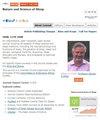Sleep Duration Irregularity is Associated with Elevated Blood Pressure During Submaximal Exercise in Young Adults
IF 3
2区 医学
Q2 CLINICAL NEUROLOGY
引用次数: 0
Abstract
Purpose: Irregularity in nightly sleep duration is reported to associate with elevated blood pressure (BP), but it is unclear whether this association can be observed with BP measured during exercise after controlling for factors known to influence the exercise pressor reflex.Methods: Twenty-nine young adults (22± 4y; 19 men, 10 women) performed cycling exercise until volitional fatigue to assess peak oxygen uptake (VO2). Actigraphy was used to monitor sleep duration and daily physical activity for seven consecutive days after which participants completed two bouts of moderate-intensity cycling while BP and VO2 were measured using a Tango+ device and indirect calorimetry, respectively. Systolic BP was averaged from the two bouts of exercise and expressed as a change from seated rest (∆SBP). Sleep duration regularity was calculated as standard deviation (SD) and coefficient of variation (CV).
Results: Systolic BP at seated rest, during exercise, and ∆SBP was 113± 13, 152± 21, and 38± 13 mmHg, respectively. Sleep duration SD (range 10– 146 min) and sleep duration CV (range 2– 54%) when excluding weekend nights were significantly correlated with ∆SBP (r = 0.58 and r = 0.62, respectively; both p< 0.01) after adjusting for age, sex, body mass index, peak VO2, physical activity, resting systolic BP, chronotype, and the VO2 response to exercise. Sleep duration regularity analyzed with weekend nights included (across all seven days) was also significantly correlated with ∆SBP (p≤ 0.01), but had weaker correlation coefficients.
Conclusion: These results indicate that sleep regularity, especially when excluding weekend nights, is associated with the rise in systolic BP during moderate-intensity exercise in young adults. Sleep duration regularity may be a useful tool to capture the impact of intermittent nights of insufficient sleep on BP dysregulation.
Keywords: sleep duration, sleep variability, blood pressure, exercise, VO2, chronotype
睡眠时间不规律与年轻人次极限运动时血压升高有关
目的:据报道,夜间睡眠时间不规律与血压(BP)升高有关,但在控制了已知会影响运动加压反射的因素后,这种关联是否与运动时测量的血压有关尚不清楚:方法:29 名年轻成年人(22± 4 岁;19 名男性,10 名女性)进行自行车运动,直到自愿疲劳为止,以评估峰值摄氧量(VO2)。连续七天使用动图监测睡眠时间和每天的体力活动,然后参与者完成两次中等强度的自行车运动,同时分别使用 Tango+ 设备和间接热量计测量血压和 VO2。收缩压是两次运动的平均值,用与静坐时相比的变化(∆SBP)表示。睡眠持续时间的规律性以标准差(SD)和变异系数(CV)计算:结果:坐位静息时收缩压、运动时收缩压和 ∆SBP 分别为 113±13、152±21 和 38±13 mmHg。在调整了年龄、性别、体重指数、峰值 VO2、体力活动、静息收缩压、慢性型和运动时 VO2 反应之后,如果不包括周末晚上,睡眠持续时间 SD(范围 10- 146 分钟)和睡眠持续时间 CV(范围 2- 54%)与 ∆SBP 显著相关(分别为 r = 0.58 和 r = 0.62;均为 p<;0.01)。包括周末夜(所有七天)在内的睡眠时间规律性分析也与∆SBP显著相关(p≤ 0.01),但相关系数较弱:这些结果表明,睡眠的规律性,尤其是排除周末晚上的睡眠规律性,与年轻人在中等强度运动时收缩压的升高有关。睡眠持续时间的规律性可能是捕捉间歇性夜间睡眠不足对血压失调影响的有用工具。
本文章由计算机程序翻译,如有差异,请以英文原文为准。
求助全文
约1分钟内获得全文
求助全文
来源期刊

Nature and Science of Sleep
Neuroscience-Behavioral Neuroscience
CiteScore
5.70
自引率
5.90%
发文量
245
审稿时长
16 weeks
期刊介绍:
Nature and Science of Sleep is an international, peer-reviewed, open access journal covering all aspects of sleep science and sleep medicine, including the neurophysiology and functions of sleep, the genetics of sleep, sleep and society, biological rhythms, dreaming, sleep disorders and therapy, and strategies to optimize healthy sleep.
Specific topics covered in the journal include:
The functions of sleep in humans and other animals
Physiological and neurophysiological changes with sleep
The genetics of sleep and sleep differences
The neurotransmitters, receptors and pathways involved in controlling both sleep and wakefulness
Behavioral and pharmacological interventions aimed at improving sleep, and improving wakefulness
Sleep changes with development and with age
Sleep and reproduction (e.g., changes across the menstrual cycle, with pregnancy and menopause)
The science and nature of dreams
Sleep disorders
Impact of sleep and sleep disorders on health, daytime function and quality of life
Sleep problems secondary to clinical disorders
Interaction of society with sleep (e.g., consequences of shift work, occupational health, public health)
The microbiome and sleep
Chronotherapy
Impact of circadian rhythms on sleep, physiology, cognition and health
Mechanisms controlling circadian rhythms, centrally and peripherally
Impact of circadian rhythm disruptions (including night shift work, jet lag and social jet lag) on sleep, physiology, cognition and health
Behavioral and pharmacological interventions aimed at reducing adverse effects of circadian-related sleep disruption
Assessment of technologies and biomarkers for measuring sleep and/or circadian rhythms
Epigenetic markers of sleep or circadian disruption.
文献相关原料
| 公司名称 | 产品信息 | 采购帮参考价格 |
|---|
 求助内容:
求助内容: 应助结果提醒方式:
应助结果提醒方式:


